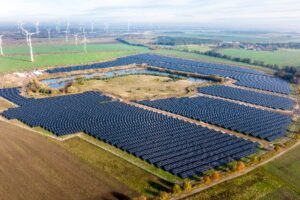Biofuels Pros And Cons

Biofuel is a fuel produced using modern biological processes such as the anaerobic digestion of organic and vegetable waste, and is used as an alternative to fossil fuels like coal and oil to lower the emissions released by engines.
What are Biofuels?
Biofuels are produced today using vegetable and animal waste (plant and agricultural waste), green algae, animal organic waste, domestic and commercial waste, farm and industrial waste.
Today, mankind produces many types of biofuels that are in solid, liquid or gaseous form.
Generations of Biofuels
Biofuels are grouped in four categories based on the type of feedstock used to produce them.
1. First Generation Biofuels
These are the biofuels that are produced from food crops.
For ethanol production, feedstocks will include corn, sugar cane, maize and other types of food crops.
For biodiesel production the feedstocks will include vegetable oils produced from soybean and canola.
2. Second Generation Biofuels
These biofuels are produced from cellulosic materials such as wood, grasses, and the inedible parts of plants.
These materials are pretty difficult to break down through fermentation, so they require a pretreatment process before the fermentation process.
Cellulosic ethanol is produced this way from poplar trees and other cellulosic materials.
3. Third Generation Biofuels
This category of biofuels is produced using the lipids from wet algae.
Unlike the crop-based biofuels that use food crops as feedstock in the production process (ethanol production in the U.S. consumes huge quantities of corn every year, which otherwise would have been used for food production), biofuels produced from algae do not require farmland or a fresh water source.
Today, we are not producing biofuels from algae at commercial scale, however many companies have purchased algae bioreactors for various purposes, including the scaling up of biofuels production up to commercial scale.
4. Fourth Generation Biofuels
Here we can find advanced biofuels such as photobiological solar fuels and electrofuels that don’t use farmland or biomass in the production process.
Types of Biofuels Manufactured Today
1. Ethanol
Ethanol is a clean fuel produced today in the U.S. using corn, poplar trees, and waste materials such as corn, straw, wheat straw, sugar cane and wood residues.
Ethanol is an alcohol produced by the fermentation process of sugars, starches and also cellulose (cellulosic ethanol).
Ethanol is a common biofuel used worldwide mixed with gasoline to improve the octane number of the fuel and reduce the level of emissions released by the engine.
2. Methanol
Methanol is a biofuel produced from natural gas, which is a fossil fuel created by the geological processes that have turned the prehistoric biological matter (dead plants and animals) into oil and gas.
Methanol is used today as fuel for racing cars in pure form or blended with gasoline.
3. Butanol
Butanol is a clean biofuel with the chemical formula (C4H9OH) that can replace gasoline better than ethanol.
Butanol works pretty well in gasoline engines without damaging the engine and without requiring any modification made to the engine.
Butanol can be produced from biomass (biobutanol), or from fossil fuels such as oil (petrobutanol), but despite the fact that different sources are used in the manufacturing process, these fuels (biobutanol and petrobutanol) have the same chemical properties.
4. Biodiesel
Biodiesel is a clean fuel produced from vegetable oil, animal fats and used cooking oil and is almost similar in composition with regular diesel fuel (petrodiesel), but releases less harmful emissions while burning.
Biodiesel is used as an alternative to fossil fuels in the transportation sector (vehicles with diesel engine, trains, planes using solajet (an algal-derived jet fuel)), as heating fuel, by diesel generators to produce cleaner electricity, and to clean oil spills (biodiesel can dissolve crude oil easily due to the fact that contains methyl esters).
5. Green Diesel
Green diesel is produced today in refineries using a process called hydrocracking and uses feedstocks such as vegetable oils and animal fats.
Green diesel is also called renewable diesel or hydrogen-derived renewable diesel, and has similar chemical properties as petrodiesel (regular diesel fuel produced from oil), which means that it can be used as a green alternative to diesel fuel.
6. Green Gasoline
Green gasoline or biofuel gasoline has been developed using a bacteria called Escherichia coli (E. coli) that can transform glucose into a cleaner gasoline (biofuel), which can be used in pure form by the engine without being blended with regular gasoline.
7. Vegetable Oil
Some types of vegetable oils are usually used for cooking, but the low-quality vegetable oil can be processed to become biodiesel.
Vegetable oil can be used as clean fuel for older diesel engines (indirect injection engines) and not for the modern diesel engines using the common rail or the integrated direct fuel injection system for diesel engines.
There are also a few companies in Europe (MAN B&W Diesel, Deutz AG, Wärtsilä and Elsbett) that have produced engines using straight vegetable oil as fuel.
Elsbett has developed professional conversion kits for diesel engines that can use straight vegetable oil instead of regular diesel fuel.
8. Solid Biomass Fuels
These types of biofuels can be used as fuel (directly or processed) to generate heat or steam that will rotate a turbine to produce electricity.
Wood can be used directly as an energy source (heating), while sawdust, different types of grass, agricultural waste, non food energy crops, domestic waste and dried manure are processed to increase the density of the biomass.
The raw biomass needs to be processed (biomass needs to be grinded) in order to produce wood pellets in the form of brick or logs that can be used in stoves or granules of fuel (pellets) that are used in boilers.
9. Syngas
Syngas, which is a mixture of carbon monoxide (CO), hydrogen (H2) and carbon dioxide (CO2) is produced due to the partial combustion of biomass.
Biomass needs to be dried before the partial combustion and sometimes is also pyrolysed.
However, the syngas resulted this way is more efficient than the direct combustion of biomass.
This is the reason why syngas can be used as fuel inside internal combustion engines.
Syngas is also used to produce hydrogen, methanol and dimethyl ether (DME).
10. Biogas
Biogas is actually the methane (CH4) released during the anaerobic digestion of organic materials such as domestic and animal waste.
To produce biogas we can also use energy crops that are fed into anaerobic digesters.
This composter is made in USA and is used to produce compost for families that produce their own plants, vegetables and fruits at home.
You can fed the composter with animal and plant waste and also domestic waste that is biodegradable.
Pros of Biofuels
Biofuels were created as an alternative to fossil fuels in order to reduce the pollution produced by the transportation and energy sectors.
1. Using Biofuels We Can Lower the Level of Air Pollution on the Planet
Burning biofuels in pure form or blended with regular fuels (produced from petroleum) will reduce the level of harmful emissions released into the atmosphere.
Being produced by biological processes such as anaerobic digestion of organic and vegetable wastes, burning biofuels will generate energy and lower emissions (no sulfur oxides or nitrogen oxides released).
2. Have a Wide Range of Applications
Biofuels are used today in the transportation sector, but also in the energy sector because they represent cleaner sources of power.
Biofuels in pure form or mixed with regular fuels (produced from oil) are used today to power vehicles with internal combustion engines, trains, planes, ships, etc. and also to produce heat or cleaner electricity.
3. Are Environmentally-Friendly Because They Are Biodegradable Products
Clean fuels produced from food crops, grasses, vegetable oil, algae, vegetable, animal and domestic waste, industrial waste, garbage and so on, will always degrade fast in nature, and will not pollute the environment.

Power plant using rapeseed for biofuels production, image source: pixabay.com
Biodiesel is a biofuel produced from vegetable oil, animal fats and used cooking oil, and due to its capacity to consume oil (contains methyl esters), it is successfully used to clean oil spills from shorelines.
4. Can Be Produced From a Wide Range of Natural Resources
Mankind produces biofuels from a very wide range of natural resources that are continuous (renewable) such as land, water, vegetation, crops and animal life.
Biofuels are also produced from domestic and industrial waste, garbage, etc., which represent resources produced by people continuously.
By using the man made resources and also the natural resources to generate biofuels, we can say that biofuels represent renewable energy sources.
5. Can Be Produced Locally to Stimulate Economic Growth
There are many countries on the planet that have no resources of fossil fuels (or only a small amount), so they need to import oil, coal and natural gas to cover the energy demand in the country.
Biofuels instead can be produced locally by planting crops and vegetation and using the waste produced by people and animals.
Using local resources to generate cleaner energy will keep the money in the country and will stimulate the economic growth.
Cons of Biofuels
Like any energy source used on the planet (clean or dirty, renewable or non-renewable), biofuels have their own disadvantages.
1. Are More Expensive than Regular Fuels Like Gasoline and Diesel
Biofuels are not produced only from domestic, industrial and animal waste or garbage, some of them (the first generation biofuels) require farmland and fresh water for crops growing.
However, the price of fuels (both biofuels and regular fuels produced from oil) depends pretty much on governmental subsidies.
2. The Production of Biofuels is Less Efficient
Ethanol is mainly produced from corn in the U.S. and its production consume more energy than the energy generated by the end product.
Biodiesel produced from soybeans seems to have the same issue, its production consumes more energy than the energy produced by the biofuel obtained this way.
3. Biofuels Are Not 100% Clean
Burning biofuels releases a small amount of harmful emissions, much smaller than the level of harmful emissions released while burning gasoline and diesel.
Biofuels are considered this way only a cleaner alternative to fossil fuels, and an energy source that despite of being renewable is not 100% clean.
4. Their Production Requires Food Crops Which May Increase the Price of Food
A very large quantity of corn is used every year in the U.S. in the production of ethanol, which otherwise would be used as a food source.
If the production of the first generation biofuels increases (these biofuels require farmland and fresh water for the crops) more and more land will be used for the crops that are turned into biofuel, and this could reduce the surface of farmland used for food production, which could increase the price of food.
5. Biofuels Have Lower Energy Density than Fossil Fuels
In terms of energy density (it shows the amount of energy that can be stored in a given mass of a substance or system), biofuels have lower outputs than fossil fuels, which means that we need to consume more biofuel than gasoline or diesel to travel the same distance.
Energy Density Of Different Fuels (MJ/kg)
- 1. Gasoline 45 – 48 MJ/kg;
- 2. Diesel 48 MJ/kg;
- 3. Coal 29 – 33 MJ/kg;
- 4. Crude Oil – 41 MJ/kg;
- 5. Natural Gas – 38 – 50 MJ/kg;
- 6. Methane (CH4) 55 MJ/kg;
- 7. Methanol (CH3-OH) 20 22 MJ/kg;
- 8. Ethanol (CH3-CH2-OH) 23 – 26 MJ/kg;
- 9. Butanol (CH3-(CH2)3-OH) 36 MJ/kg;
- 10. Biodiesel 38 MJ/kg.
Conclusion
Biofuels represent today a cleaner alternative to fossil fuels, but in order to replace the regular fuels (gasoline and diesel) used to run our cars we need to produce biofuels at commercial scale and not only locally.
At the same time we need to stop using food crops as feedstock for biofuel production, the number of people on the planet rises every year and we need all the available farmland and fresh water to produce food instead of fuels.







